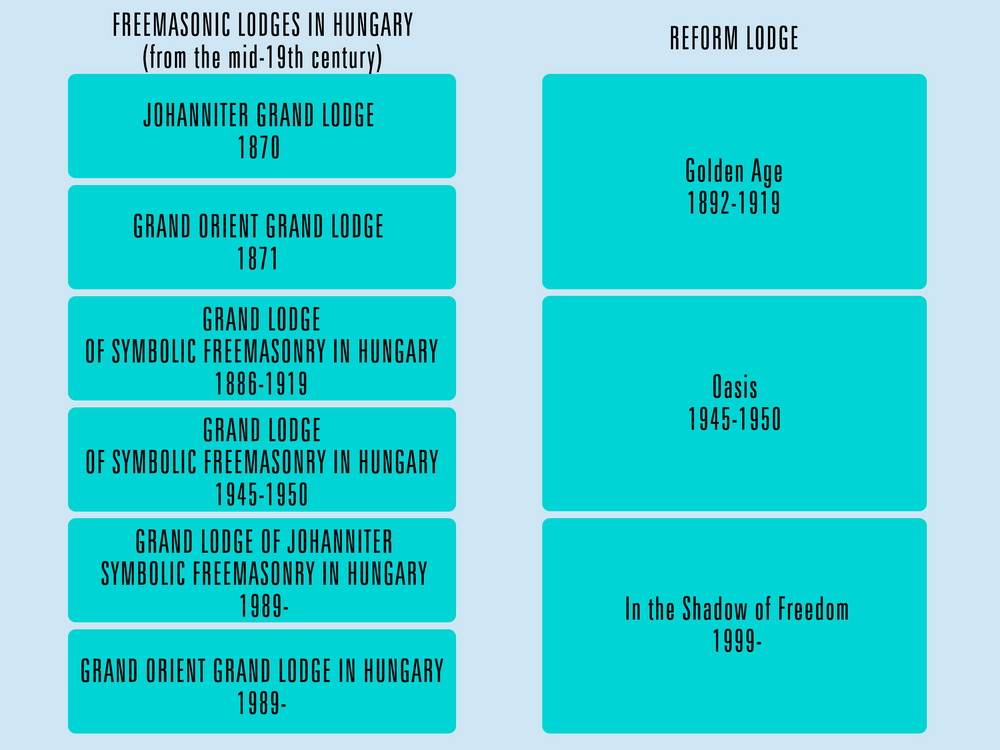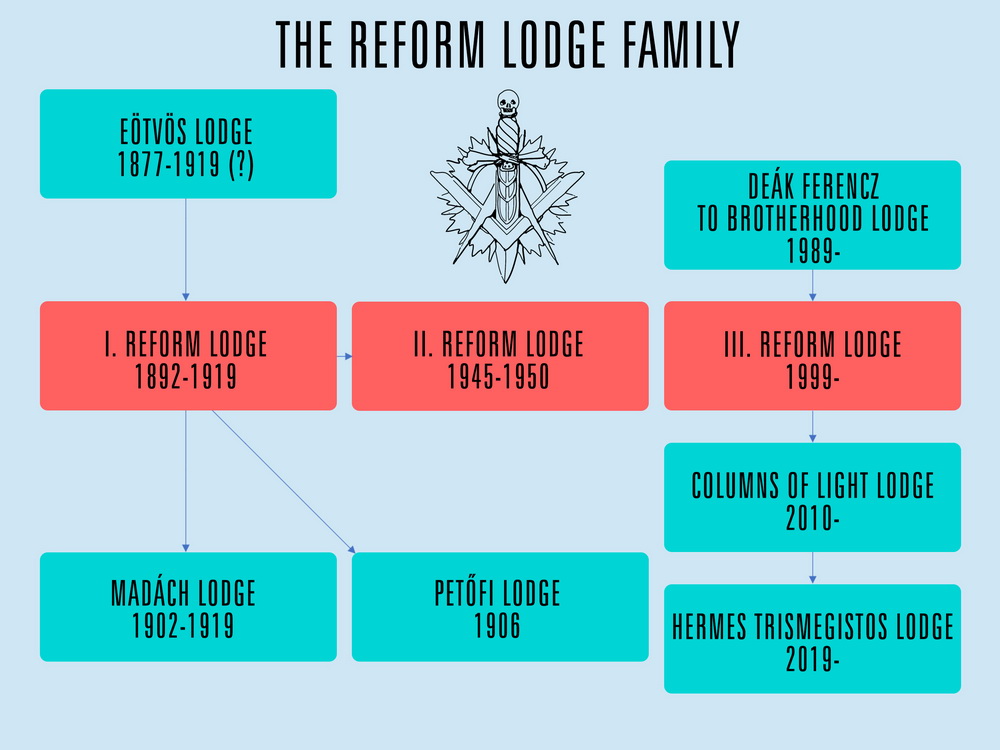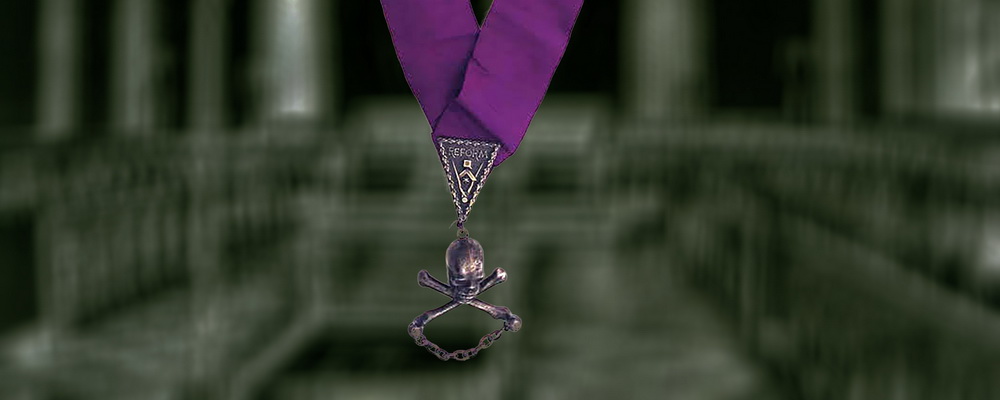THE HISTORY OF THE REFORM LODGE
Founded in 1892, the history of
the Reform Lodge also confirms that „as the state of human society was,
so was Freemasonry, and vice versa.” (Lessing: Masonic Dialogues)
The Reform Lodge has been founded (and re-founded) three times, and
along with Hungarian Freemasonry as a whole, it was banned twice by
oppressive, freedom-hating totalitarian regimes.
Although during these bans, brothers met informally, and there were
informal Masonic gatherings – both domestically and abroad – less than
half of the more than 130 years since the first founding have allowed
the lodge to function within regular frameworks.

Reform I.
The Golden Age (1892-1919)
The Reform Lodge was founded on April 24, 1892. (after receiving permission
from the Grand Lodge) It held its first regular meeting a few weeks
later and thereafter met weekly.
The fifteen founders separated from the Eötvös Lodge, and the first
Grand Master was József Merényi. In his inaugural speech, he spoke about
the age and the duties of Freemasons as follows:
„Today, everyone thinks, creates, and invents, from the simple craftsman
to the great scientist; the merchant just as much as the scholar. (...)
Birth, rank, and religious differences have taken on more obvious measures
than ever before; the tyranny of prejudice has become entrenched, and
the disease of social hierarchy thrives, as if we were not standing
at the threshold of the 20th century, but stumbling through the darkest
period of the Middle Ages.”
„There are no strong, influential brothers to change society, our field of activity is the moral world. We must establish the limit beyond which, in the fight for existence, we can advance to protect our own interests, without violating our brothers’ interests, and spread this principle in society.”
„We must choose the right tools and go in the right direction: we begin work on ourselves. We will leave the comfortable path of empty words behind; we do not wish to waste our energy on futile work but will strive to act in a way that leaves visible traces and allows us to enjoy the fruits of our labor.”
Regarding the name "Reform":
„It is not Freemasonry that needs reforming, but we must create
close, sincere, and friendly bonds within ourselves.”
On the motto:
„Let the first word of our motto be: brotherhood! But to arouse
a sense of brotherhood among us, first and foremost, it is necessary
that we are sincere with each other in our interactions! Never let our
words betray our feelings, nor our actions betray our words. Let us
have the courage to tell each other the truth, even if gently – but
let us also courageously and without despair accept the truth. Our 'yes'
should be yes, and our 'no' should be no! Therefore, let the second
word of our motto be: sincerity... However, we can only be sincere if
we have the reassuring knowledge that the sincere word spoken in friendship
will find a quiet place. Our third word should be silence!”
The number of members had already reached twenty-nine the following
year. The Reform Lodge participated in the founding of a children's
camp during the holiday season and various charitable fundraising events.
Over a decade later, in 1905, the lodge organized a two-day Masonic
convention, addressing topics such as the social program, church affairs,
protection of domestic industry, and education. These topics indicate
that the Reform Lodge – like other lodges – worked on solving many important
societal issues, demonstrating active social shaping intentions. This
intention grew stronger over the next few years.
The Reform Lodge became one of the largest lodges in Hungarian Freemasonry. Its members founded the Madách (1902) and Petőfi lodges (1906).

Reform II.
The Oasis (1945-1950)
In the history of Hungarian Freemasonry, the periods of bans are often referred to as biblical desert wanderings in the memories of Freemasons. The period between 1945 and 1950 revitalized Freemasonry like an oasis after the Second World War, when Freemasonry was allowed to operate for a few years.
On December 8, 1945, the second Reform Lodge's temporary leadership was formed. Several new members joined alongside twenty-five old members who had been initiated during the previous era and five brothers initiated in Vienna during the ban. By the end of 1946, the Reform Lodge had 107 members, a number that grew to 131 over the next three years.
During these years, the Reform Lodge was one of the most active and largest Masonic lodges. Members continued the tradition of meeting weekly, with the lodge's intellectual and administrative life being organized and led by lodge committees.
In 1950, Freemasonry was banned again in Hungary, and the Reform Lodge ceased to exist once more.
Reform III.
In the Shadow of Freedom (1999-)
The revived (third) Reform Lodge was founded in 1999, following the
initiative of seven founders who had separated from the Deák Ferencz,
Testvériséghez Lodge, one of whom’s grandfather had been a member of
the Reform Lodge before 1950.
Once again, the lodge requested permission from the Hungarian Symbolic
Grand Lodge to begin its activities. Today, with about 400 members,
the Reform Lodge remains a medium-sized but active lodge, meeting bi-weekly.
Its operation and rules are based on the original goals and moral principles
set forth at its founding.
Famous Figures from the History of the Reform Lodge
Several notable individuals from Hungarian society were part of the
Reform Lodge, including:
• Clair Vilmos, fencer, author of a multiple edition dueling code
• Hajós Alfréd, Hungary’s first Olympic champion, architect
• Telcs Ede, sculptor
• Kernstock Károly, painter
• Kovách Aladár, first director of the ambulance service created by
Freemasons
• Róth Miksa, glass artist, painter
And many others: doctors, artists, bankers, senior officials, entrepreneurs, teachers.

(Hajós Alfréd's victory medal from 1896 - Hungary's first Olympic gold
medal)
